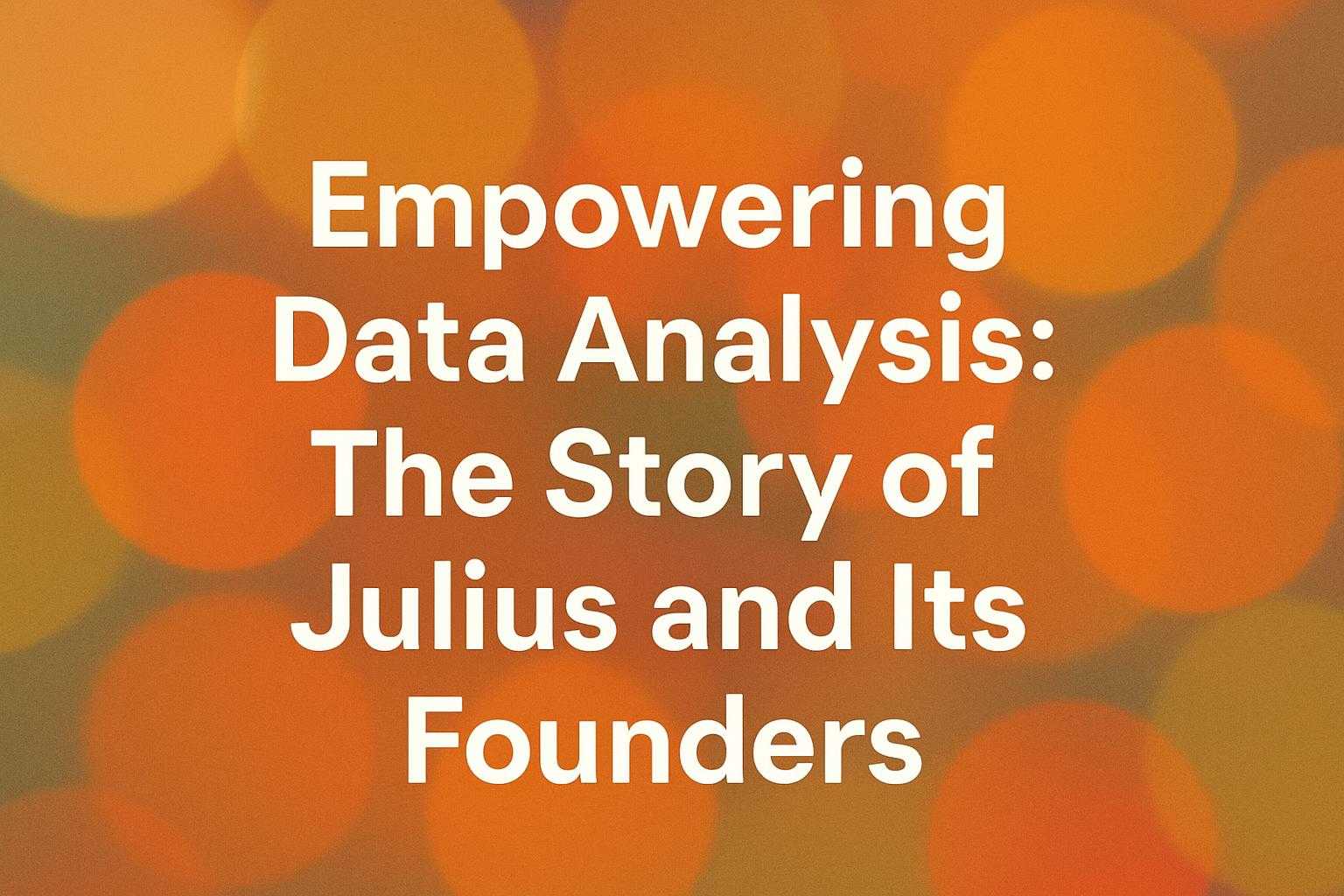Empowering Data Analysis: The Story of Julius and Its Founders

Company profile
Company business details
Problem that their product solves
Julius solves the problem of making data analysis accessible to non-technical users. The end users are professionals across various fields who need to analyze data but lack the coding skills typically required for such tasks. Solving this problem is important as it empowers these users to make data-driven decisions without relying on data scientists.Their unfair advantage
Julius's unfair advantage lies in its ability to simplify complex data analysis through natural language processing, allowing users to interact with data without needing extensive programming knowledge.Strategies
Idea Validation Stage
Building a Personal Email Service
In his early years, Rahul Sunwalker attempted to create an email service after losing access to his Gmail account. He signed up for a domain and convinced 12 of his friends to join, allowing them to have personalized email addresses. This initiative not only showcased his entrepreneurial spirit but also served as a practical lesson in user acquisition and product-market fit, even if it was on a small scale.
Pre-Launch (Product Development & MVP)
Twitter Prank for Buzz Generation
Rahul, the founder of Julius AI, executed a spontaneous Twitter prank to generate buzz around his startup. He noticed reporters outside Twitter HQ while heading to the gym and decided to play a prank by walking out with a box, pretending to be leaving the company. He texted a friend to bring two boxes, and they walked out together, which caught the attention of the reporters. This prank unexpectedly went viral, leading to significant media coverage and increased awareness of Julius AI, showcasing the power of creative marketing tactics in the early stages of a startup.
User Engagement via Personal Contact
Rahul implemented a unique pricing strategy for Julius where the highest tier included direct access to his phone number. This approach allowed users to provide feedback directly, fostering a personal connection and ensuring that their voices were heard. This strategy not only helped in prioritizing user feedback but also created a community around the product, enhancing user loyalty and engagement.
Creating Podcast Comments Platform
Rahul launched podcastcomments.com, a platform designed to provide a unified comment section for podcasts. He spent a month developing a barebones version, inspired by the engaging comment sections he enjoyed on YouTube. However, he realized too late that he should have validated the idea before coding, leading to a lack of user interest upon launch.
User-Centric Feedback Loop
The founder of Julius implemented a strategy of collecting user feedback from day one of launching their product. They decided to offer users the option to pay for the service immediately, which allowed them to gauge genuine interest and commitment from users. This approach helped them differentiate between casual feedback and serious user engagement, leading to valuable insights that shaped their product roadmap. By directly engaging with paying users, they could ask targeted questions about their needs and preferences, ensuring that the product evolved in a way that truly addressed user problems.
Launch Stage
Iterative Launching of Julius
Rahul's company, Julius, underwent multiple iterations before finding its product-market fit. Initially focused on SQL, they pivoted to Python, which allowed for more complex data analysis. The launch on July 12, coinciding with Julius Caesar's birthday, marked a significant milestone, as they finally attracted a user base that resonated with their offering.
User-Centric Feedback Loop
After launching Julius AI, Rahul implemented a user-centric feedback loop by providing his personal phone number to paid users. This allowed users to text him directly with questions or feedback, creating a direct line of communication. This approach not only helped in gathering candid feedback but also fostered a sense of community and trust among users. When the platform experienced downtime, users reached out to him, providing real-time insights into their experiences, which helped the team prioritize improvements and maintain user satisfaction.
The Twitter Prank
Rahul, known for his viral prank of faking his firing from Twitter, leveraged this event to gain significant media attention. He texted his friends to join him at the gym with cardboard boxes, creating a scene that attracted reporters. This spontaneous act not only went viral but also positioned him as a notable figure in the startup community, leading to increased visibility for his future endeavors, including his startup Julius.
Experimentation and Iteration
During the launch stage, the founder embraced a culture of experimentation, allowing the team to try various ideas and pivot as necessary. They went through six different pivots before landing on the current concept of Julius. Each failed experiment provided insights that informed the next steps, leading to a more refined understanding of the market and user needs. This iterative process was crucial in developing a product that resonated with users, as they learned from each attempt and adjusted their approach accordingly.
Growth Stage
Hackathon Engagement with WaterView
During his time at hackathons, Rahul developed WaterView, a tool that simplified the setup process for projects by providing out-of-the-box solutions for backend services. He actively promoted it by encouraging participants to download it to save time during competitions. This strategy helped him gain traction, but he learned that retention was low as users did not continue using the tool after the events.
Leveraging Social Media for Product Updates
Rahul actively shared updates and new features of Julius on social media, ensuring that users were aware of ongoing improvements. This strategy helped maintain user interest and engagement, as it demonstrated a commitment to continuous development and responsiveness to user needs, ultimately driving word-of-mouth referrals.
Leveraging ChatGPT Plugin Store
To drive initial user acquisition, Rahul and his team created multiple plugins for the ChatGPT Plugin Store, which allowed users to analyze data easily. They optimized their plugin names to rank higher in search results, leading to a significant influx of users. This strategy was particularly effective in attracting users who were already familiar with AI tools and looking for data analysis solutions.
Iterative Product Development
Rahul emphasized the importance of rapid iteration and shipping new features frequently. By constantly engaging with users and gathering feedback, the team was able to refine Julius quickly. This approach not only kept the product relevant but also demonstrated to users that the team was actively working to improve their experience, which helped in retaining users and attracting new ones.
Community Building through User Recognition
Rahul actively recognized and celebrated users of Julius by sharing their success stories on social media. This strategy not only boosted user morale but also encouraged others to share their experiences, creating a community around the product. By highlighting how users were leveraging Julius in innovative ways, he fostered a sense of belonging and loyalty among the user base.
AI-Driven User Experience
Julius was designed to provide a seamless user experience by allowing users to interact with the AI in natural language. The AI could generate visualizations and insights based on user queries, making data analysis accessible to non-technical users. This focus on user-friendly AI interactions helped differentiate Julius from competitors and attracted a broader audience.
Focus on User Experience and Accuracy
As Julius AI grew to half a million users, Rahul emphasized building a seamless user experience and ensuring the accuracy of code generation. The team focused on reducing errors by collecting metrics on common code issues and implementing solutions to prevent them. For instance, they developed a system where the AI could automatically install missing modules before executing code, thereby minimizing user frustration. This commitment to user experience and reliability became a key differentiator for Julius AI in a competitive market.
Educational Use Cases and Workflows
Recognizing the potential for educational applications, Rahul and his team began developing 'workflows' within Julius AI. These workflows serve as templates for users to learn how to perform specific tasks, such as financial analysis or data visualization, using natural language prompts. This feature was inspired by a professor who used Julius to teach a class, demonstrating the tool's capability to facilitate learning. By focusing on educational use cases, Julius AI aims to empower users who may not have a technical background, further broadening its user base.
Building a Strong Company Culture
As the company grew, the founder focused on creating a culture that encouraged exploration and innovation. They emphasized the importance of having fun while working, which helped to lower the stakes for employees and foster a more creative environment. This culture allowed team members to feel comfortable taking risks and making mistakes, which ultimately led to more innovative solutions and a stronger product. The founder believed that a company's culture should reflect the values of its leadership, and they worked to ensure that Julius embodied a spirit of curiosity and experimentation.
Maturity & Scaling
User-Centric Development and Feedback Loop
To enhance user engagement and product quality, Rahul emphasized the importance of user feedback. He personally interacted with power users to understand their pain points and iterated on product features based on their input. This hands-on approach not only improved the product but also fostered a community of loyal users who felt valued and heard.
Infrastructure Investment for Scalability
To support the rapid growth of Julius AI, Rahul invested in robust infrastructure, utilizing GCP for hosting. The team built a system of sandboxed virtual machines to ensure user data security and prevent malicious activity. This infrastructure allowed for quick provisioning of resources, which was crucial during spikes in user activity. After experiencing a significant outage due to a sudden influx of users, the team learned to implement better scaling strategies and timeouts, ensuring a more reliable service as they continued to grow.
Strategic Hiring and Team Growth
In the maturity stage, the founder adopted an opportunistic hiring strategy, focusing on bringing in talent that aligned with the company's mission and culture. They sought engineers who not only had technical skills but also a strong sense of product taste and user empathy. This approach ensured that new hires would contribute positively to the company's culture and help drive the product's success. By prioritizing cultural fit and shared values, the founder aimed to build a cohesive team that could effectively tackle the challenges of scaling the business.
Saturation & Retention
Building a Personal Brand
Rahul focused on building a personal brand that reflected his authentic self, combining humor with seriousness. By being genuine and relatable, he attracted a following that resonated with his journey and the values of his company. This personal connection helped in establishing trust and loyalty among users and potential investors.
Educational Partnerships and User Engagement
To enhance user engagement and retention, the founder established partnerships with educational institutions, such as a top business school that planned to teach a class on data analysis using Julius. This initiative aimed to introduce Julius to a new generation of users and create a community of knowledgeable advocates for the product. By integrating Julius into academic curricula, the founder sought to position the product as an essential tool for future professionals, thereby increasing its visibility and user base.
Learn more about Julius

The AI Data Scientist | Rahul Sonwalkar, Juilius AI

Rahul Sonwalkar: Founder of Julius

Building Julius AI to 500.000 users w/ Rahul (founder)



